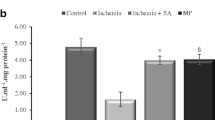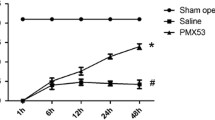Abstract
The main causes of spinal cord ischemia are a variety of vascular pathologies causing acute arterial occlusions. We investigated neuroprotective effects of coumaric acid on spinal cord ischemia injury in rats. Rats were divided randomly into four groups of eight animals as follows: control, ischemia, ischemia + coumaric acid, and ischemia + methylprednisolone. In the control group, only a laparotomy was performed. In all other groups, the spinal cord ischemia was performed by the infrarenal aorta cross-clamping model. Levels of malondialdehyde and nuclear respiratory factor 1 were analyzed, as were the activity of superoxide dismutase. Histopathological and immunohistochemical evaluations were performed. Neurological evaluation was performed with the Tarlov scoring system. The ischemia + coumaric acid group was compared with the ischemia group, and a significant decrease in malondialdehyde and levels was observed. Nuclear respiratory factor 1 level and superoxide dismutase activity of the ischemia + coumaric acid group were significantly higher than in the ischemia group. In histopathological samples, the ischemia + coumaric acid group is compared with the ischemia group, and there was a significant increase in numbers of normal neurons. In immunohistochemical staining, hypoxia-inducible factor-1α and NF-kappa B immunopositive neurons were significantly decreased in the ischemia + coumaric acid group compared with that in the ischemia group. The neurological deficit scores of the ischemia + coumaric acid group were significantly higher than the ischemia group at 24 h. Our results revealed for the first time that coumaric acid exhibits meaningful neuroprotective activity following ischemia-reperfusion injury of the spinal cord.





Similar content being viewed by others
References
Carden, D.L., and D.N. Granger. 2000. Pathophysiology of ischaemia-reperfusion injury. The Journal of Pathology 190: 255–266.
Ginsberg, M.D. 2003. Adventures in the pathophysiology of brain ischemia: penumbra, gene expression, neuroprotection. Stroke 34: 214–223.
Manoli, I., S. Alesci, M.R. Blackman, et al. 2007. Mitochondria as key components of the stress response. Trends in Endocrinology and Metabolism 18: 190–198.
Kong, C.S., C.H. Jeong, J.S. Choi, K.J. Kim, and J.W. Jeong. 2013. Antiangiogenic effects of p-coumaric acid in human endothelial cells. Phytotherapy Research 27: 317–323.
King, A., and G. Young. 1999. Characteristics and occurrence of phenolic phytochemicals. Journal of the American Dietetic Association 99: 213–218.
Luceri, C., L. Giannini, M. Lodovici, et al. 2007. p-Coumaric acid, a common dietary phenol, inhibits platelet activity in vitro and in vivo. The British Journal of Nutrition 97: 458–463.
Luceri, C., F. Guglielmi, M. Lodovici, et al. 2004. Plant phenolic 4-coumaric acid protects against intestinal inflammation in rats. Scandinavian Journal of Gastroenterology 39: 1128–1133.
Seo, Y.K., S.J. Kim, Y.C. Boo, et al. 2011. Effects of p-coumaric acid on erythema and pigmentation of human skin exposed to ultraviolet radiation. Clinical and Experimental Dermatology 36: 260–266.
Zang, L.Y., G. Cosma, H. Gardner, et al. 2000. Effect of antioxidant protection by p-coumaric acid on low-density lipoprotein cholesterol oxidation. American Journal of Physiology 279: 954–960.
Cho, J.Y., J.H. Moon, K.Y. Seong, and K.H. Park. 1998. Antimicrobial activity of 4-hydroxybenzoic acid and trans 4-hydroxycinnamic acid isolated and identified from rice hull. Bioscience Biotechnology and Biochemistry 62: 2273–2276.
Pragasam, S.J., V. Murunikkara, E.P. Sabina, and M. Rasool. 2013. Ameliorative effect of p-coumaric acid, a common dietary phenol, on adjuvant-induced arthritis in rats. Rheumatology International 33: 325–334.
Gurer, B., H. Kertmen, E. Kasim, et al. 2015. Neuroprotective effects of testosterone on ischemia/reperfusion injury of the rabbit spinal cord. Injury 46: 240–248.
Yilmaz, E.R., H. Kertmen, H. Dolgun, et al. 2012. Effects of darbepoetin-alpha in spinal cord ischemia-reperfusion injury in the rabbit. Acta Neurochirurgica 154: 1037–1043.
Kertmen, H., B. Gurer, E.R. Yilmaz, et al. 2013. The protective effect of low-dose methotrexate on ischemia-reperfusion injury of the rabbit spinal cord. European Journal of Pharmacology 714: 148–156.
Zivin, J.A., and U. DeGirolami. 1980. Spinal cord infarction: a highly reproducible stroke model. Stroke 11: 200–202.
Tarlov, I.M. 1972. Acute spinal cord compression paralysis. Journal of Neurosurgery 36: 10–20.
Lowry, O.H., N.J. Rosebrough, A.L. Farr, and R.J. Randall. 1951. Protein measurement with the Folin phenol reagent. The Journal of Biological Chemistry 193: 265–275.
Gutsaeva, D.R., M.S. Carraway, H.B. Suliman, et al. 2008. Transient hypoxia stimulates mitochondrial biogenesis in brain subcortex by a neuronal nitric oxide synthase-dependent mechanism. The Journal of Neuroscience 28: 2015–2024.
Sun, Y., L.W. Oberley, and Y. Li. 1988. A simple method for clinical assay of superoxide dismutase. Clinical Chemistry 34: 497–500.
Buege, J.A., and S.D. Aust. 1978. Microsomal lipid peroxidation. Methods in Enzymology 52: 302–310.
Folwarczna, J., M. Zych, J. Burczyk, H. Trzeciak, and H.I. Trzeciak. 2009. Effects of natural phenolic acids on the skeletal system of ovariectomized rats. Planta Medica 75: 1567–1572.
Hudson, E.A., P.A. Dinh, T. Kokubun, M.S. Simmonds, and A. Gescher. 2000. Characterization of potentially chemopreventive phenols in extracts of brown rice that inhibit the growth of human breast and colon cancer cells. Cancer Epidemiology, Biomarkers & Prevention 9: 1163–1170.
Stanely Mainzen Prince, P., and A.J. Roy. 2013. p-Coumaric acid attenuates apoptosis in isoproterenol-induced myocardial infarcted rats by inhibiting oxidative stress. International Journal of Cardiology 168: 3259–3266.
Janicke, B., G. Onning, and S.M. Oredsson. 2005. Differential effects of ferulic acid and p-coumaric acid on S phase distribution and length of S phase in the human colonic cell line Caco-2. Journal of Agricultural and Food Chemistry 53: 6658–6665.
Barros, M.P., M. Lemos, E.L. Maistro, et al. 2008. Evaluation of antiulcer activity of the main phenolic acids found in Brazilian green propolis. Journal of Ethnopharmacology 120: 372–377.
Karavelioglu, E., Y. Gonul, S. Kokulu, et al. 2014. Anti-inflammatory and antiapoptotic effect of interleukine-18 binding protein on the spinal cord ischemia-reperfusion injury. Inflammation 37: 917–923.
Kurt, G., Z. Yildirim, B. Cemil, E. Celtikci, and G.T. Kaplanoglu. 2014. Effects of curcumin on acute spinal cord ischemia-reperfusion injury in rabbits. Laboratory investigation. Journal of Neurosurgery 20: 464–470.
Johann, S., M. Dahm, M. Kipp, C. Beyer, and S. Arnold. 2010. Oestrogen regulates mitochondrial respiratory chain enzyme transcription in the mouse spinal cord. Journal of Neuroendocrinology 22: 926–935.
Gorlach, A., and S. Bonello. 2008. The cross-talk between NF-kappaB and HIF-1: further evidence for a significant liaison. The Biochemical Journal 412: 17–19.
Conflict of Interest
The authors declare that they have no competing interests and financial disclosure.
Author information
Authors and Affiliations
Corresponding author
Rights and permissions
About this article
Cite this article
Guven, M., Sehitoglu, M.H., Yuksel, Y. et al. The Neuroprotective Effect of Coumaric Acid on Spinal Cord Ischemia/Reperfusion Injury in Rats. Inflammation 38, 1986–1995 (2015). https://doi.org/10.1007/s10753-015-0179-0
Published:
Issue Date:
DOI: https://doi.org/10.1007/s10753-015-0179-0




